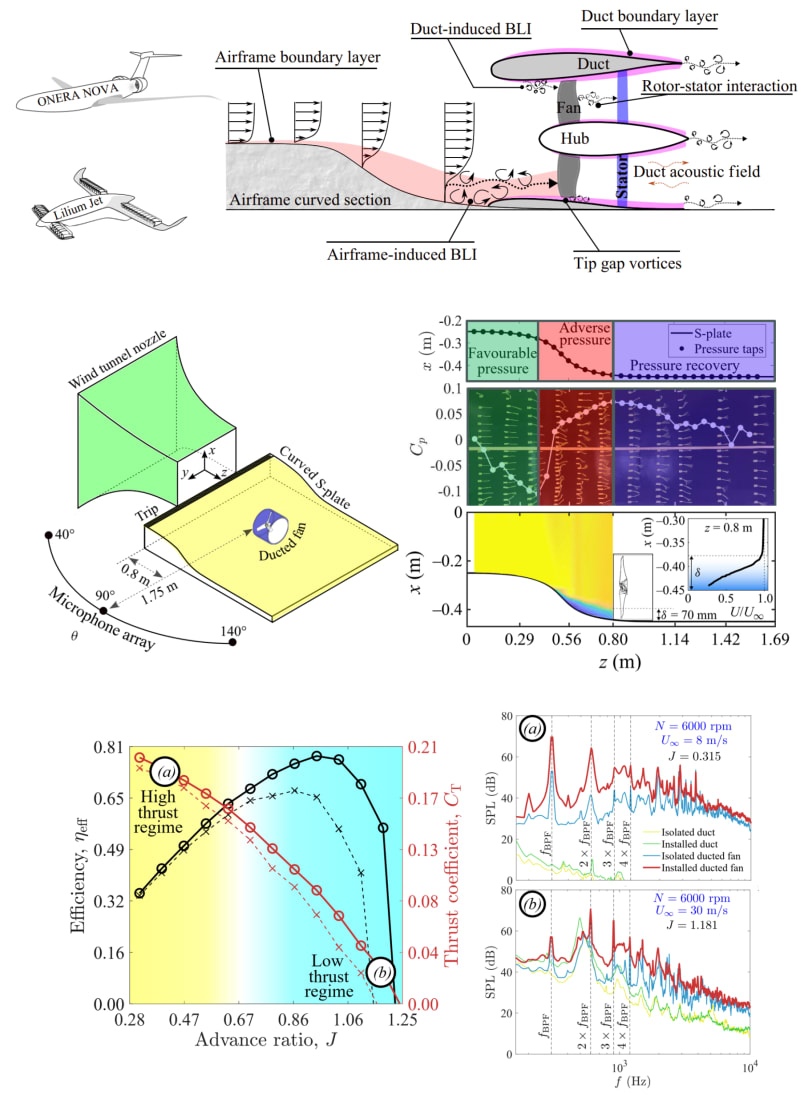

Electric ducted fan propulsion systems are gaining attention for their potential to power next-generation aircraft towards NetZero emissions. These systems can be mounted away from the airframe or embedded within it, the latter being known as Boundary Layer Ingesting (BLI) ducted fans. BLI ducted fans, also known as embedded engines, are partially integrated into the plane's main body. They ingest air from both the front and the airframe surface, requiring less effort to move the plane, thereby reducing fuel consumption and emissions. However, noise generation has been a significant barrier to their adoption.
Our design study at the University of Bristol’s National Aeroacoustic Wind Tunnel Facility investigated the noise generation mechanisms of BLI ducted fans. We identified noise sources from the duct, rotating fan, and airflow over the curved airframe surface. The noise patterns vary with thrust levels: at high thrust, the noise is similar to non-ducted fans, while at low thrust, the duct significantly modifies the noise.
Noise is a major hurdle for public acceptance and certification of future electric aircraft, including Urban Air Mobility (UAM) vehicles like drone taxis. Current guidelines for aircraft noise are underdeveloped for these air vehicles, complicating vehicle certification. Our study addresses this urgent issue by revealing the physics behind the noise produced by these configurations. Understanding these noise sources is crucial for designing effective noise control devices, moving away from the trial and error methods previously used in the aerospace sector.
We designed a BLI test rig with an electric ducted fan mounted next to a curved wall, replicating embedded engines in advanced aircraft like the ONERA NOVA and NASA/MIT Aurora D8. Using a source decomposition method, we dissected the noise into components, providing a clear understanding of the physics of noise origin and variation with different fan thrust levels. This research fills a knowledge gap by examining noise produced by ducted fans on curved airframe surfaces, unlike previous studies focusing on flat surfaces and fans without ducts.
The insights from our study have applications in various aircraft designs, from large future commercial airplanes (such as ONERA NOVA, NASA/MIT Aurora D8, and Airbus Nautilus) to small eVTOL aircraft (such as Bell X-22A, Embraer X, Airbus E-fan, and LiliumJet). The demand for quieter, more efficient aircraft is growing, driven by the need for sustainable aviation solutions and enhanced passenger comfort.
Implementing noise reduction strategies from our research involves optimizing the design of ducted fans and their integration with the airframe. These improvements can be incorporated into the manufacturing processes with relatively low additional costs, focusing on design modifications rather than entirely new production techniques.
Our design contributes to the public by improving the quality of life through quieter, more comfortable air travel. It helps prevent noise-related health issues and enhances public safety. Additionally, it supports the reduction of carbon emissions and noise pollution, aligning with the goal of achieving NetZero emissions in aviation. The innovation also promotes economic growth by enabling the development of advanced aircraft technologies and creating jobs in the aerospace sector.
-
Awards
-
 2024 Aerospace & Defense Honorable Mention
2024 Aerospace & Defense Honorable Mention -
 2024 Top 100 Entries
2024 Top 100 Entries
Like this entry?
-
About the Entrant
- Name:Feroz Ahmed
- Type of entry:teamTeam members:
- Feroz Ahmed
- Ismaeel Zaman
- Djamel Rezgui
- Mahdi Azarpeyvand
- Patent status:none








